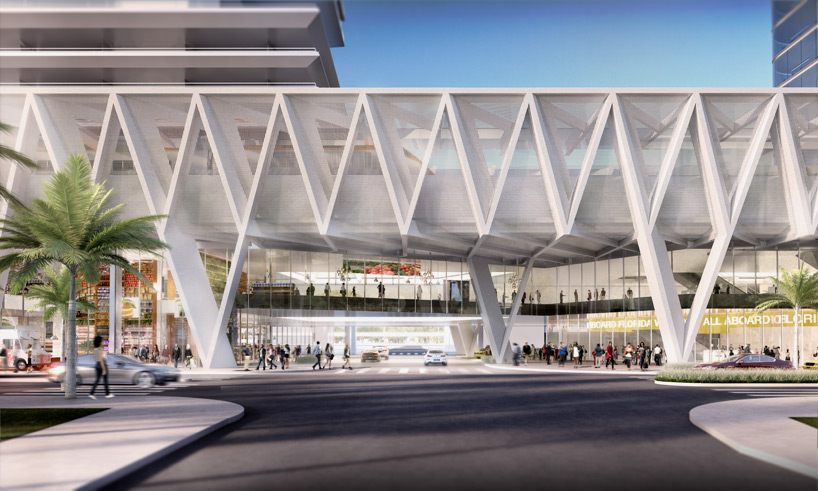As a part of the overarching project All Aboard Florida, Skidmore, Owings, and Merrill has designed a multimodal transit hub for Miami, one of three that will eventually connect Miami to Orlando by train.
The station will serve an estimated 12 million Floridians each year, and is meant to eliminate at least three million car trips each year.
The main terminal is located about 50 feet above street level. The space below will be full of retail spaces; the elevated terminal will allow for all roadside properties to remain leaseable, according to designboom.
“This project is a true celebration of the power and potential of transit-oriented development,” Roger Duffy, Design Partner at SOM, said in a press release. “We are excited to continue working with All Aboard Florida to realize this vibrant infrastructural undertaking, unparalleled in its scope, scale, and vision.”
Passenger service is expected to begin in 2016.
Here is SOM's full press release on the project:
In a ceremony today, Miami Mayor Tomás Pedro Regalado, Miami-Dade County Mayor Carlos A. Gimenez, and All Aboard Florida executives unveiled designs for All Aboard Florida’s new multimodal hub for Miami, planned and designed by Skidmore, Owings & Merrill LLP (SOM). In addition to the Miami hub, SOM is also planning and designing All Aboard Florida’s passenger stations in Fort Lauderdale and West Palm Beach, which will be unveiled at a later date.
All Aboard Florida is the only privately owned, operated and financed project of its kind being developed in the United States today. All Aboard Florida’s 235-mile network of rail lines will connect South Florida to Orlando by utilizing the current rail infrastructure for the Florida East Coast Corridor between Miami and the Space Coast and creating new tracks into Central Florida. The transformational infrastructure project will provide a vital new service for Florida residents, business people, and visitors and eliminate more than three million car trips from the region’s roadways each year. Passenger service is anticipated to begin in late 2016.
“An estimated 12 million travelers will benefit from the Miami station,” says Michael Reininger, President and Chief Development Officer, All Aboard Florida. “All Aboard Florida provides a fast and convenient transit alternative for this growing demand and need, while integrating transportation infrastructure with mixed use development to serve as a catalyst for transformation and economic vitality in a city that is quickly becoming a model for urban living today.”
“This project is a true celebration of the power and potential of transit-oriented development,” states Roger Duffy, Design Partner at SOM. “We are excited to continue working with All Aboard Florida to realize this vibrant infrastructural undertaking, unparalleled in its scope, scale, and vision.” Florida?based Zyscovich Architects is serving as the project’s Associate Architect and Planner.

renderings courtesy SOM / © SOM
SOM’s three stations will be key portals within All Aboard Florida’s rail system. Envisioned not only as gateways to their respective cities, but also as iconic destinations, the terminals will be filled with spaces to shop, eat, and meet. In downtown Miami, SOM has responded to an extraordinarily challenging and dense site by elevating the railways 50 feet in the air. Retail spaces are vertically layered beneath the soaring tracks and ample use of glass will give the station a shimmering, lightweight quality. This innovative solution allows thru-streets to remain open to traffic and for valuable streetfront real estate to remain leasable. Moreover, this bold architectural gesture creates a landmark terminal—a symbol of a 21st-century Miami.
As pieces of urban infrastructure, the stations are positioned to become centers of gravity for significant urban redevelopment. Economists estimate that All Aboard Florida will pump more than $6 billion into the Florida economy over the next eight years.
“Florida is poised to become the third largest state in the nation due to population growth,” said Kristopher Takacs, SOM Project Manager. “All Aboard Florida responds to this swelling demand by providing a fast and convenient transit alternative to the state’s highways and airport terminals. By integrating this transportation infrastructure with future mixed-use development, the terminals will be the catalysts to transform these cities locally, regionally, and globally.”
SOM has more than seven decades of experience in planning, designing, and implementing large?scale city-building projects that combine transportation infrastructure with urban mixed-use development. In the past twenty years alone, SOM has completed more than $5 billion dollars worth of transportation construction projects around the world, including complex intermodal and multimodal facilities, subway and rail stations, ferry terminals, the design of entire airports and more than a dozen airport terminals.

renderings courtesy SOM / © SOM
All Aboard Florida is an intercity passenger rail project being developed by Florida East Coast Industries, Inc. (FECI) — owner of Florida’s premier passenger rail corridor — that will connect Miami to Orlando with intermediate stations in Fort Lauderdale and West Palm Beach. This rail service will give Floridians and visitors a viable transportation alternative to congested highways and airport terminals. All Aboard Florida will provide a high?quality experience for passengers and will be the first privately owned, operated, and maintained passenger rail system in the United States. For more information, visit www.AllAboardFlorida.com.
About Florida East Coast Industries, Inc.
Florida East Coast Industries, Inc. (FECI), through its subsidiaries and affiliates, is one of Florida’s oldest and largest integrated, full?service real estate and infrastructure companies. Headquartered in Coral Gables, FL, FECI has a rich history dating back over a century when Henry Flagler first established the company which became a pioneer in the development of Florida’s eastern coast.
About Zyscovich Architects
Zyscovich Architects (Zyscovich) is an international master planning, architecture, and interior design firm with offices in Miami, West Palm Beach, Orlando, New York City, Bogotá, and Tobago. The firm's innovative approach to planning, Real Urbanism™, embraces the history and economics of a community to create a unique vision that brings tangible value and improved quality of life to the area. The firm's commitment to customized solutions is also evident in its award winning architectural design work for both public and private clients. Zyscovich's broad range of experience includes large?scale mixed?use, transportation, educational, commercial, retail, multi?family residential, and hospitality projects.
About Skidmore, Owings & Merrill LLP
Skidmore, Owings & Merrill LLP (SOM) is one of the leading architecture, interior design, engineering, and urban?planning firms in the world, with a 75?year reputation for design excellence and a portfolio that includes some of the most important architectural accomplishments of the 20th and 21st centuries. Since its inception, SOM has been a leader in the research and development of specialized technologies, new processes and innovative ideas, many of which have had a palpable and lasting impact on the design profession and the physical environment. The firm’s longstanding leadership in design and building technology has been honored with more than 1,700 awards for quality, innovation, and management. The American Institute of Architects has recognized SOM twice with its highest honor, the Architecture Firm Award—in 1962 and again in 1996. The firm maintains offices in New York, Chicago, San Francisco, Los Angeles, Washington, D.C., London, Hong Kong, Shanghai, Mumbai and Abu Dhabi.
Related Stories
Museums | Aug 11, 2010
Design guidelines for museums, archives, and art storage facilities
This column diagnoses the three most common moisture challenges with museums, archives, and art storage facilities and provides design guidance on how to avoid them.
| Aug 11, 2010
Broadway-style theater headed to Kentucky
One of Kentucky's largest performing arts venues should open in 2011—that's when construction is expected to wrap up on Eastern Kentucky University's Business & Technology Center for Performing Arts. The 93,000-sf Broadway-caliber theater will seat 2,000 audience members and have a 60×24-foot stage proscenium and a fly loft.
| Aug 11, 2010
Citizenship building in Texas targets LEED Silver
The Department of Homeland Security's new U.S. Citizenship and Immigration Services facility in Irving, Texas, was designed by 4240 Architecture and developed by JDL Castle Corporation. The focal point of the two-story, 56,000-sf building is the double-height, glass-walled Ceremony Room where new citizens take the oath.
| Aug 11, 2010
Carpenters' union helping build its own headquarters
The New England Regional Council of Carpenters headquarters in Dorchester, Mass., is taking shape within a 1940s industrial building. The Building Team of ADD Inc., RDK Engineers, Suffolk Construction, and the carpenters' Joint Apprenticeship Training Committee, is giving the old facility a modern makeover by converting the existing two-story structure into a three-story, 75,000-sf, LEED-certif...
| Aug 11, 2010
Utah research facility reflects Native American architecture
A $130 million research facility is being built at University of Utah's Salt Lake City campus. The James L. Sorenson Molecular Biotechnology Building—a USTAR Innovation Center—is being designed by the Atlanta office of Lord Aeck & Sargent, in association with Salt-Lake City-based Architectural Nexus.
| Aug 11, 2010
San Bernardino health center doubles in size
Temecula, Calif.-based EDGE was awarded the contract for California State University San Bernardino's health center renovation and expansion. The two-phase, $4 million project was designed by RSK Associates, San Francisco, and includes an 11,000-sf, tilt-up concrete expansion—which doubles the size of the facility—and site and infrastructure work.
| Aug 11, 2010
Goettsch Partners wins design competition for Soochow Securities HQ in China
Chicago-based Goettsch Partners has been selected to design the Soochow Securities Headquarters, the new office and stock exchange building for Soochow Securities Co. Ltd. The 21-story, 441,300-sf project includes 344,400 sf of office space, an 86,100-sf stock exchange, classrooms, and underground parking.
| Aug 11, 2010
New hospital expands Idaho healthcare options
Ascension Group Architects, Arlington, Texas, is designing a $150 million replacement hospital for Portneuf Medical Center in Pocatello, Idaho. An existing facility will be renovated as part of the project. The new six-story, 320-000-sf complex will house 187 beds, along with an intensive care unit, a cardiovascular care unit, pediatrics, psychiatry, surgical suites, rehabilitation clinic, and ...
| Aug 11, 2010
Colonnade fixes setback problem in Brooklyn condo project
The New York firm Scarano Architects was brought in by the developers of Olive Park condominiums in the Williamsburg section of Brooklyn to bring the facility up to code after frame out was completed. The architects designed colonnades along the building's perimeter to create the 15-foot setback required by the New York City Planning Commission.









